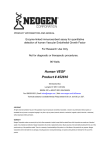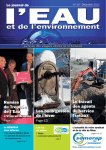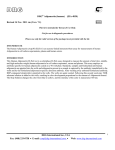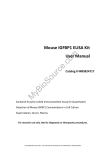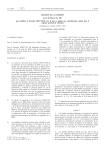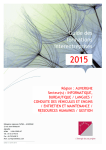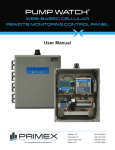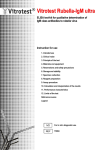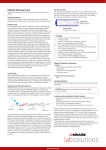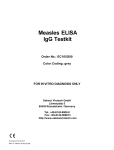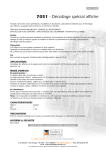Download IFU - DRG International
Transcript
DRG® VEGF (human) (EIA-4819) Revised 18 Nov. 2011 rm (Vers. 6.1) RUO This kit is intended for Research Use Only. Not for use in diagnostic procedures. Please use only the valid version of the package insert provided with the kit. INTENDED USE The VEGF ELISA is an enzyme-linked immunosorbent assay for measurement of human VEGF levels (vascular endothelial growth factor) in cell culture supernatants, human serum, plasma (EDTA, heparin and citrate) CSF and urine. INTRODUCTION This human VEGF ELISA kit is an enzyme-linked immunosorbent assay (ELISA) for measurement of human VEGF in cell culture supernatants, serum, plasma, CSF and urine. This assay employs an antibody specific for human VEGF coated onto a 96-well plate. Standards, samples and biotinylated anti-human VEGF are pipetted into the wells and VEGF present in a sample is captured by the antibody immobilized to the wells and by the biotinylated VEGF-specific detection antibody. After washing away unbound biotinylated antibody, HRP-conjugated streptavidin is pipetted into the wells. The wells are again washed. Following this second wash step, TMB substrate solution is added to the wells, resulting in blue color development proportional to the amount of VEGF bound. The stop solution changes the color from blue to yellow, and the intensity of the color is measured at 450 nm. CONTENTS OF THE KIT TEST COMPONENTS AMOUNT/VOLUME MICROTITER PLATE: 96 WELL PLATE WITH 12 STRIPS BREAK-APART MICROTITER TEST STRIPS EACH WITH 8 VEGF ANTIBODY COATED SINGLE WELLS. READY FOR USE 1 FRAME VEGF165 STANDARD 4200 PG/ML LYOPHILIZED &STABILIZED RECOMBINANT HUMAN VEGF165, RECONSTITUTE WITH THE SAMPLE DILUENT VOLUME SHOWN ON THE LABEL. 2 X 1 ML BIOTINYLATED VEGF ANTIBODY. STABILIZED. READY FOR USE. 10 ML HRP-CONJUGATED AVIDIN. STABILIZED. READY FOR USE. 12 ML DRG International Inc., USA Fax: (908) 233-0758 E-mail: [email protected] Web: www.drg-international.com 1 DRG® VEGF (human) (EIA-4819) Revised 18 Nov. 2011 rm (Vers. 6.1) RUO 20X WASH BUFFER CONCENTRATE (SUFFICIENT FOR 1000ML) DILUTE 1:20 50 ML SAMPLE DILUENT READY FOR USE 100 ML STOP SOLUTION 0.9 N H2SO4 READY FOR USE 8 ML TMB-SUBSTRATE READY FOR USE 8 ML 1 QUALITY CONTROL CERTIFICATE STORAGE AND STABILITY Reagent Storage Stability Antibody coated 96 well plates with 12 strips. Store at 2-8°C in closed aluminum bag with desiccant 3 months after opening Break-apart microtiter test strips each with 8 antibody coated single wells Strips which are not used must be stored in the re-sealable aluminum bag in humidity free and airtight conditions VEGF165 Standard lyophilized Store at 2-8°C Until date of kit expiry in lyophilized format. Unstable. Use immediately after dissolving. Keep on ice if not used within 1 hr after dissolving Biotinylated antibody. Ready for use. Store at 2-8°C Avoid contamination (Use clean sterile tips) 3 months after opening HRP-Conjugated Avidin. Ready for use. Store at 2-8°C Avoid contamination (Use clean sterile tips) 3 months after opening DRG International Inc., USA Fax: (908) 233-0758 E-mail: [email protected] Web: www.drg-international.com 2 DRG® VEGF (human) (EIA-4819) Revised 18 Nov. 2011 rm (Vers. 6.1) RUO Sample Diluent Store at 2-8°C Avoid contamination (Use clean sterile tips or pipettes) 3 months after opening 20x Concentrated Wash Buffer Store at 2-8°C To avoid crystal formation, wash buffer concentrate, may also be stored at Room Temperature. Until expiry date Diluted Wash Buffer 1x working dilution 1 week at room temperature Bottles used for the working dilution should be or one month at 2-8 °C cleaned regularly, discard cloudy solutions TMB-Substrate Solution Store at 2-8°C, protected from light! Avoid contamination (Use clean sterile tips) Until expiry date Stop Solution Store at 2-8°C May also be stored at Room Temperature Until expiry date ADDITIONAL MATERIALS REQUIRED Microplate reader capable of measuring absorbance at 450 nm. Precision pipettes (2 µL to 1 mL volumes). Multi-channel pipette (25 µL to 350 µL). Adjustable 1-25 mL pipettes for reagent preparation. 100 mL and 1 liter graduated cylinders. Absorbent paper. Distilled or de-ionized water. Log-log graph paper or computer and software for ELISA data analysis. Tubes to prepare standard or sample dilutions. Timer DRG International Inc., USA Fax: (908) 233-0758 E-mail: [email protected] Web: www.drg-international.com 3 DRG® VEGF (human) (EIA-4819) Revised 18 Nov. 2011 rm (Vers. 6.1) RUO AMOUNTS OF THE REAGENTS NEEDED TO PERFORM THE TEST REAGENTS NO OF STRIPS USED (8 WELL EACH) BIOTINYLATED ANTIBODY 50 µL/WELL AVIDINHRP 50µL/WELL TMB SUBSTRATE 50 µL/WELL STOP SOLUTION 25 µL/WELL WASH BUFFER 300 µL/WELL 1 (8 WELLS) 500 µL 500 µL 500 µL 300 µL 30 ML 2 (16 WELLS) 1 ML 1 ML 1 ML 600 µL 55 ML 4 (32 WELLS) 2 ML 2 ML 2 ML 1.2 ML 110 ML 6 (48 WELLS) 3 ML 3 ML 3 ML 1.8 ML 165 ML 8 (64 WELLS) 4 ML 4 ML 4 ML 2.4 ML 220 ML 12 (96 WELLS) 6 ML 6 ML 6 ML 4 ML 350 ML REAGENT AND SAMPLE PREPARATION Note: All reagents and samples must be allowed to equilibrate to room temperature (18-25°C) before use. 1. Antibody coated plate: Before opening the foil pouch, determine the number of strips required to test the desired number of samples, plus 16 wells needed for running standards and blanks in duplicate. Remove non-used strips from the plate-frame and return them to the foil pouch containing the desiccant for up to 3 months at 2-8°C. 2. Dilution of test standard: Dissolve the lyophilised VEGF standard with Sample Diluent volume shown on the label. VEGF standard is unstable after dissolving. Use immediately or keep on ice if not used within 1 hr after dissolving. a. Take 100 µL of VEGF165 from kit standard tube containing 4200 pg/mL of VEGF and pipet into Standard tube 1. Add 500 µL of sample diluent to obtain VEGF concentration of 700 pg/mL in the first dilution tube (total volume 600 µL). b. Add 200 µL of Sample Diluent to all other 4 dilution tubes. Take 100 µL from the first tube (700 pg/mL) and start 3-fold serial dilutions in dilution tubes as described in the figure by mixing several times with the pipette in each tube (Total of 5 dilution tubes). c. 200 µL of Sample Diluent serves as zero standard (0 ng/mL) in tube 6. DRG International Inc., USA Fax: (908) 233-0758 E-mail: [email protected] Web: www.drg-international.com 4 DRG® VEGF (human) (EIA-4819) Revised 18 Nov. 2011 rm (Vers. 6.1) RUO 100 µL of Standard (4200 pg/mL) + 500 µL of Sample Diluent 100.µL 2 100 µL 100 µL 100 µL 100 µL 200 µL of Sample Diluent 700 pg/mL 3. 4. 233 pg/mL 78 pg/mL 26 pg/mL 9 pg/mL 0 pg/mL Sample preparation and dilution: Dilution of samples is not required for initial screening. Samples that exceed the measuring range should be diluted serially in sample diluent and measured again. Samples with absorbance values >1.900 can be serially diluted 1:2, 1:4, 1:8, or further if necessary. The dilution factor must be taken in account when calculating the results. Dilute and store all samples in tubes or plates made of material with low binding surface, such as polypropylene. Sample collection and storage: Serum, EDTA, heparin or citrate anti-coagulated plasmas, cerebrospinal fluid, cell culture supernatants and urine are suitable sample types for use in the assay (caution: separate plasma/serum and blood cells within 4 hours after collection, non-separated samples must be kept in temperatures from +2-8°C). Do not use grossly haemolyzed or lipemic specimens. If samples are to be run within 24 hours, they may be stored at +2-8°C; otherwise samples should be stored frozen (at least between -18 to -32°C, but preferably < -70°C). Up to 3 freeze-thaw cycles have no effect on the VEGF levels of samples. Nonetheless, excessive freeze-thaw cycles should be avoided. Prior to the assay, frozen samples should be thawed as quickly as possible in tap water (18-25°C). Do not use 37°C or 56°C water bath for this purpose. DRG International Inc., USA Fax: (908) 233-0758 E-mail: [email protected] Web: www.drg-international.com 5 DRG® VEGF (human) (EIA-4819) Revised 18 Nov. 2011 rm (Vers. 6.1) 5. RUO Preparation of reagents: a. Wash Buffer: If the 20x concentrated Wash Buffer contains visible crystals, warm it at 37°C and mix gently until dissolved. Dilute 1:20 with de-ionized or distilled water (e.g. 25 mL of Wash Buffer Concentrate and 475 mL distilled water to yield 500 mL of 1x Wash Buffer). Check the pH of the diluted wash buffer and adjust to 7.4 if necessary. b. Vortex mix green colored biotinylated antibody solution gently before use. c. Vortex mix blue colored peroxidase (HRP) labeled avidin gently before use. Caution: TMB substrate (Tetramethylbenzidine) and Stop solution (H2SO4) are toxic or corrosive and should be handled with care. Use gloves during handling. TEST PROCEDURE SUMMARY 1. Prepare all reagents, samples and standards. Dilution of samples not required at initial screening. 2. Add 50 µL standard (starting from 700 pg/mL), test samples and sample diluent as a blank into the appropriate wells of the strips. Incubate 1 hours at room temperature. Wash 5x. 3. Add 50 µL ready for use biotin antibody promptly to each well. Incubate 1 hour at room temperature. Wash 5x. 4. Add 50 µL ready for use HRP-Streptavidin solution. Incubate 30 minutes at room temperature. Wash 5x. 5. Add 50 µL TMB Substrate Reagent to each well. Incubate 20 minutes at room temperature. 6. Add 25 µL Stop Solution to each well. Read at 450 nm against *630 nm immediately. Subtract blank values from values for standards and test samples *Correcting for optical imperfections in the microplates by subtracting A630 nm is recommended, but not an essential procedure. DRG International Inc., USA Fax: (908) 233-0758 E-mail: [email protected] Web: www.drg-international.com 6 DRG® VEGF (human) (EIA-4819) Revised 18 Nov. 2011 rm (Vers. 6.1) RUO TEST PRINCIPLE DRG International Inc., USA Fax: (908) 233-0758 E-mail: [email protected] Web: www.drg-international.com 7 DRG® VEGF (human) Revised 18 Nov. 2011 rm (Vers. 6.1) (EIA-4819) RUO PROCEDURAL NOTES/LAB QUALITY CONTROL o When not in use, kit components should be kept refrigerated. All reagents should be warmed to room temperature before use. o Microtiter plates should be allowed to come to room temperature before opening the foil bags. o Once the desired number of strips has been removed, immediately return unused strips to the bag, reseal the bag and store at +2 - 8°C to maintain plate integrity. Protect from humidity. o Samples should be collected in pyrogen/endotoxin-free tubes. o Samples should be frozen if not analyzed shortly after collection. Avoid multiple freeze-thaw cycles of frozen samples. Thaw completely and mix well prior to analysis. o When possible, avoid the use of badly hemolyzed or lipemic sera. If large amounts of particulate matter are present, centrifuge or filter prior to analysis. o It is recommended that all standards, controls and samples are run in duplicate. o Samples that are > 700 pg/mL should be diluted with Sample Diluent. o When pipetting reagents, maintain a consistent order of addition from well-to-well. This ensures equal incubation times for all wells. o Cover or cap all reagents when not in use. o Do not use reagents past their expiration date. o Read absorbencies within 20 minutes of assay completion. o In-house controls should be run with every assay. If control values fall outside pre-established ranges, the accuracy of the assay is suspect. o All residual wash buffer must be drained from the wells by efficient aspiration or by decantation followed by tapping the plate forcefully on absorbent paper. Never insert absorbent paper directly into the wells. o Because TMB substrate solution is light sensitive, avoid prolonged exposure to light. Also avoid contact between TMB substrate solution and metal, or color may develop. DRG International Inc., USA Fax: (908) 233-0758 E-mail: [email protected] Web: www.drg-international.com 8 DRG® VEGF (human) (EIA-4819) Revised 18 Nov. 2011 rm (Vers. 6.1) RUO ASSAY PROCEDURE 1. Bring all reagents and samples to room temperature (18 - 25°C) before use. It is recommended that all standards and samples are run at least in duplicate. Leave some wells as a reagent blank (2 to 4 wells). 2. 3. 4. FIRST STEP: STANDARD, SAMPLES AND BLANK+ BIOTINYLATED ANTIBODY Pipette 50 µL of sample and 50 µL of each diluted standard starting from 1200 pg/mL (see chapter 7) into appropriate wells. Pipette 50 µL of sample diluent to the wells which will be used as a blank. Incubate 1 hour at room temperature SECOND STEP: BIOTINYLATED ANTIBODY Wash 5x with 1x Wash Solution (300 µL each) To wash manually: Empty plate contents. Use a multi-channel pipette to fill each well with 300 µL of diluted wash buffer, then empty plate contents again. Repeat procedure 4 additional times for a total of FIVE washes. Gently blot plate onto paper towels or other absorbent material. Never let reaction wells dry. Continue to the next step without delay or interruption. For automated washing: Aspirate all wells and wash 5 times with 300 µL diluted wash buffer. Blot plate onto paper towels or other absorbent material. Never let reaction wells dry. Continue to the next step without delay or interruption. Promptly add 50 µL of green colored Biotinylated VEGF detection antibody to all wells Tap the plate gently by hand to homogenize your mixture. Avoid touching to the reaction wells with pipet tip. Incubate at room temperature for 1 hour without shaking. 5. 6. THIRD STEP: HRP-CONJUGATED AVIDIN Wash 5 times 5x as described in Step 3. Add 50 µL of prepared HRP-conjugated avidin solution (ready to use) to each well. Incubate for 30 minutes at room temperature. FOURTH STEP: TMB SUBSTRATE 7. Wash 5 times as described in Step 3 8. Using a multichannel pipet, promptly add 50 µL of TMB ready to use substrate reagent to each well. Incubate for 20 minutes at room temperature in the dark. 9. Add 25 µL of Stop Solution to each well. Read at 450 nm within 15 minutes. Correcting for optical imperfections in the microplates by subtracting A630 nm is recommended, but not an essential procedure. FIFTH STEP: READING AND CALCULATION 10. Calculate the mean of reagent blank absorbance values and subtract it from all test well values (standard and test samples). Mean reagent blank absorbance value at 450 nm should be less than 0.200. 11. Calculate your results against standard curve, as outlined below. DRG International Inc., USA Fax: (908) 233-0758 E-mail: [email protected] Web: www.drg-international.com 9 DRG® VEGF (human) (EIA-4819) Revised 18 Nov. 2011 rm (Vers. 6.1) RUO CALCULATION OF RESULTS The standard curve must be determined individually for each experiment. Correct the absorbance values of all standards by subtracting from them the O.D. value of the reagent blank (Bl = only sample diluent). Calculate the mean absorbance value for each standard from the duplicates. The standard curve is used to determine the amount of VEGF in an unknown sample. The standard curve is generated by plotting the average O.D. (450 nm) obtained for each of the standard concentrations on the vertical (Y) axis versus the corresponding VEGF concentration (pg/mL) on the horizontal (X) axis. Construct the standard curve using graph paper or statistical software. If samples generate values higher than the highest standard, dilute the samples with sample diluent and repeat the assay. Note that the concentration read from the standard curve must be multiplied by the dilution factor. TEST PERFORMANCE VEGF ASSAY RANGE STANDARD CURVE POINTS 9-700 PG/ML 700, 233, 78, 26, 9 AND 0 PG/ML. INTRA-ASSAYPRECISION ≤ 6% INTER-ASSAYPRECISION ≤ 10% INTER-LOTPRECISION ≤ 12% CROSS-REACTIVITY NO CROSS-REACTIVITY WAS OBSERVED WITH THE FOLLOWING RECOMBINANT HUMAN PROTEINS: IL-1, IL-1ß, IL-2, IL-3, IL-4, IL-5, IL-6, IL-7, IL-8, IL-9, IL-10, IL-12, IL-13, TNF Α, TARC SPECIFICITY RECOGNIZES BOTH NATURAL AND RECOMBINANT HUMAN VEGF165. ISOFORM VEGF121 CROSS-REACTS 100% IN THE ASSAY. SENSITIVITY < 5 PG/ML. TYPICAL DATA The following standard curve is obtained for the various VEGF standards over the range of 0 to 1200 pg/ml. The graph also shows the calibration data of WHO reference reagent compared to the kit standard. Please note: This graph is an example only. A standard curve should be generated each time the assay is performed. Do not use this table in your calculations. DRG International Inc., USA Fax: (908) 233-0758 E-mail: [email protected] Web: www.drg-international.com 10 DRG® VEGF (human) Revised 18 Nov. 2011 rm (Vers. 6.1) (EIA-4819) RUO REFERENCES / LITERATURE 1. Ferrara, N., Houck, K., Jakeman, L., and Leung, D.W. (1992). Molecular and biological properties of the vascular endothelial growth factor family of proteins. Endocr. Rev. 13, 18-32. 2. Ferrara N. (2002). Timeline: VEGF and the quest for tumour angiogenesis factors. Nat Rev Cancer 2, 795-803. 3. Tischer, E., Mitchell, R., Hartmann, T., Silva, M., Gospodarowicz, D., Fiddes, J.C., and Abraham, J.A. (1991). The human gene for vascular endothelial growth factor. Multiple protein forms are encoded through alternative exon splicing. J. Biol. Chem. 266, 11947-11954. 4. Ferrara, N., Winer, J., and Burton, T. (1991). Aortic smooth muscle cells express and secrete vascular endothelial growth factor. Growth Factors 5, 141-148. 5. Pertovaara, L., Kaipainen, A., Mustonen, T., Orpana, A., Ferrara, N., Saksela, O., and Alitalo, K. (1994). Vascular endothelial growth factor is induced in response to transforming growth factor-b in fibroblastic and epithelial cells. J. Biol. Chem. 269, 6271-6274. DRG International Inc., USA Fax: (908) 233-0758 E-mail: [email protected] Web: www.drg-international.com 11 DRG® VEGF (human) Revised 18 Nov. 2011 rm (Vers. 6.1) 6. 7. 8. (EIA-4819) RUO Brown, L.F., Yeo, K.-T., Berse, B., Yeo, T.K., Senger, D.R., Dvorak, H.F., and van de Water, L. (1992). Expression of vascular permeability factor (vascular endothelial growth factor) by epidermal keratinocytes during wound healing. J. Exp. Med. 176, 1375-1379. Berse, B., Brown, L.F., Van de Water, L., Dvorak, H.F., and Senger, D.R. (1992). Vascular permeability factor (vascular endothelial growth factor) gene is expressed differentially in normal tissues, macrophages, and tumors. Am. J. Pathol. 3, 211-220. Ladoux, A., and Frelin, C. (1993). Hypoxia is a strong inducer of vascular endothelial growth factor mRNA expression in the heart. Biochem. Biophys. Res. Commun. 195, 1005-1010. LIABILITY This kit is intended for research use only by personnel trained and qualified to carry out research activities. If the recipient of this kit passes it on in any way to a third party, this instruction must be enclosed, and said recipient shall at own risk secure in favor of DRG all limitations of liability herein. DRG shall not be responsible for any damages or losses due to using the kit in any way other than as expressly stated in these Instructions. The liability of DRG shall in no event exceed the commercial value of the kit. DRG shall under no circumstances be liable for indirect, special or consequential damages, including but not limited to loss of profit. DRG International Inc., USA Fax: (908) 233-0758 E-mail: [email protected] Web: www.drg-international.com 12 DRG® VEGF (human) (EIA-4819) Revised 18 Nov. 2011 rm (Vers. 6.1) RUO TROUBLESHOOTING PROBLEM POOR STANDARD CURVE LOW SIGNAL LARGE CV HIGH BACKGROUND LOW SENSITIVITY CAUSE SOLUTION 1. INACCURATE PIPETTING OR PIPETTING ERROR CHECK PIPETTES AND CALIBRATE REGULARLY. 2. IMPROPER STANDARD DILUTION VORTEX THE STOCK BEFORE USE AND DILUTE CAREFULLY IN AN EPPENDORF TUBE. 1. SHORTER INCUBATION THAN RECOMMENDED ENSURE SUFFICIENT INCUBATION TIME; 2. INADEQUATE REAGENT VOLUMES OR IMPROPER DILUTION OR PIPETTING ERROR CHECK PIPETTES AND ENSURE CORRECT PERFORMANCE. INACCURATE PIPETTING AND DRYING OF WELLS DURING TEST PROCEDURE. CHECK PIPETTES. 1. PLATE IS WASHED INSUFFICIENTLY REVIEW THE MANUAL FOR PROPER WASH. IF USING A PLATE WASHER, CHECK THAT ALL PORTS ARE UNOBSTRUCTED AND CLEAN. 2. CONTAMINATED WASH BUFFER MAKE A FRESH WASH BUFFER 3. WASH BUFFER VOLUME IS LESS THAN ADVISED USE 300 µL PER WELL 1. IMPROPER STORAGE OF THE ELISA KIT STORE TEST KIT COMPONENTS AS ADVISED IN THIS USER MANUAL. KEEP SUBSTRATE SOLUTION PROTECTED FROM LIGHT. 2. STOP SOLUTION 3. CONTAMINATION OF REAGENTS FILL THE WELLS PROMPTLY WITH WASH BUFFER AND REAGENTS. STOP SOLUTION SHOULD BE ADDED TO EACH WELL BEFORE MEASURE. USE CLEAN STERILE TIPS. DISCARD CONTAMINATED REAGENTS. Version 2011-10-05 cc DRG International Inc., USA Fax: (908) 233-0758 E-mail: [email protected] Web: www.drg-international.com 13













